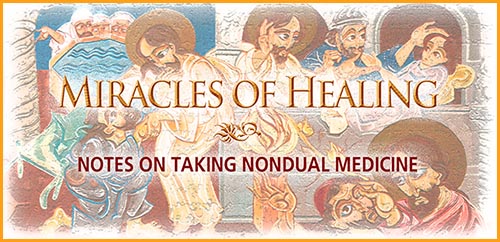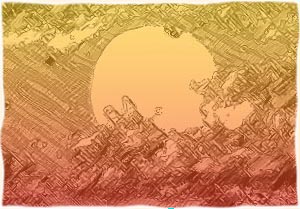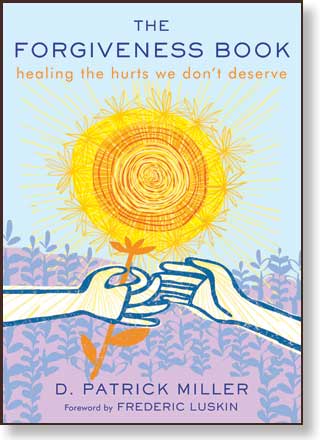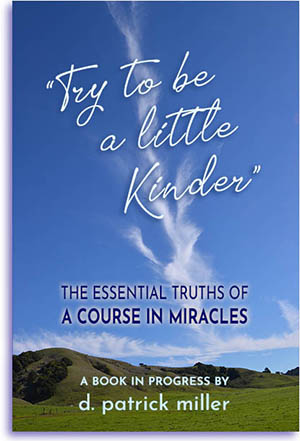
______________________
If you knew nothing of A Course in Miracles, the first time you heard that odd phrase you might think it referred to some kind of training to facilitate miracles of physical healing: sudden cancer remission, an impossible awakening from coma, instantly regaining the capacity to walk after paralysis. Such miracles do occur but they are rare and unexpected, even if we have been wishing or praying for them. Thus the idea of a “course,” that is, a curriculum that teaches us to perform or experience miracles might seem outlandish.
But since A Course in Miracles (ACIM) is a real thing that has been with us for nearly fifty years, drawing a steadily growing following of millions across the world, it’s worth asking if it delivers on that suggestive premise. Is the Course really a reliable training in learning to experience or facilitate miracles of physical healing?
As someone whose initial engagement with ACIM led to a complete healing from a severe and chronic physical malady, I can provide the definitive answer: “Well, it is and it isn’t” — with the essential corollary: “It depends.”
 I was 32 when I was struck with a mysterious new illness, then just being noticed nationwide, that would soon be called Chronic Fatigue Syndrome (CFS). I’ve reported on that experience in detail elsewhere, so I won’t reprise the whole story here. It suffices to say that I exhausted multiple medical approaches, including alternatives such as acupuncture, crystal healing, and desperate wishing before I grudgingly accepted the possibility that the sudden onset of chaos in my body might have something to do with the long-standing miasma of my mind. That realization led to about nine weeks of psychotherapy and, during that same period, the discovery of A Course in Miracles.
I was 32 when I was struck with a mysterious new illness, then just being noticed nationwide, that would soon be called Chronic Fatigue Syndrome (CFS). I’ve reported on that experience in detail elsewhere, so I won’t reprise the whole story here. It suffices to say that I exhausted multiple medical approaches, including alternatives such as acupuncture, crystal healing, and desperate wishing before I grudgingly accepted the possibility that the sudden onset of chaos in my body might have something to do with the long-standing miasma of my mind. That realization led to about nine weeks of psychotherapy and, during that same period, the discovery of A Course in Miracles.
Because ACIM was befuddling from the get-go, I was not expecting it to have a healing effect. Frankly, I didn’t have the slightest idea of what it might do to me, even though I felt a peculiar and growing attraction. Yet since I was experiencing a significant degree of “brain fog,” I thought that attraction might mean I was on the way to losing my troubled mind.
And that, in fact, is exactly what happened over the next seven years, as my study deepened in tandem with a halting but progressive healing from CFS. I gradually learned to release substantial territories of my mind that had been devoted to anger, resentment, and grief (and I’m glad to say those territories would never be regained). As those inner troubles dissipated, the various maddening symptoms of my body’s failure slowly eased. From that process I learned the extent to which my errancies of mind had been creating my physical ailments. There was not always a one-to-one, logical correspondence, but an energetic parallel was undeniable.
The Mind-Body Problem
The problem with expecting the Course to deliver miracles of physical healing is that it generally looks upon the body not just with disdain, but with a near-total dismissal: “At no single instant does the body exist at all" (ACIM, T-18.VII). This is in keeping with ACIM’s insistence that we are profoundly mistaken in identifying ourselves as separate bodies and egos making our way through a hazardous world of time and space.
Per the Course, we are in fact held within the infinite, loving, and timeless abstraction that is the Mind of God. “Let me remember I am one with God,” Workbook Lesson 124 instructs; “God is but love and therefore so am I” says a Workbook motif that is repeated no less than thirty times. Believing that we are anything else stems from a ridiculously mistaken thought at which we subsequently forgot to laugh. From that failure of humor and humility we drew our entire apparent existence as lonely, embodied beings doomed to die:
“Into eternity, where all is one, there crept a tiny, mad idea, at which the Son of God remembered not to laugh. In his forgetting did the thought become a serious idea, and possible of both accomplishment and real effects.” (ACIM, T-27.VIII)
This “say again??” diagnosis of the human condition is what identifies the Course as a teaching of “pure nonduality.” That’s the philosophical construct that there is only one reality (see Mind of God, above). Unfortunately, the ‘reality’ we experience everyday ain’t it. In truth, there are no opposed dichotomies like God and humanity, body and spirit, love and hate, and so on. All those dualities are proof of our witless exchange of the loving, seamless eternity of God for a separated, delusory incarnation.
In the Christian metaphor, our pained existence results from the “original sin” committed by Eve and Adam in the Garden of Eden. That’s when the Old Testament God, for unknown but possibly malicious reasons, granted the Serpent the right to tempt that unlucky pair of original humans with a gamble of Paradise. All he had to do was proffer an apple and murmur, “Wanna trade in your silly bliss for some hardcore knowledge?” Like total idiots, they went for it.
Per the Course, however, the fix was already in before the Serpent’s chicanery — for male and female is another of those false dualities that sprang from our prior loss of infinity, innocence and grace.
It is this dualistic world of loss, pain, and ever-looming death that we are forever trying to fix. We doggedly seek peace in a world where war has historically driven economies; we poignantly pursue true love in a psychological swampland of egocentricity; and finally we strive for perfect health and life extension against an everyday backdrop of illness, physical limitations, and inescapable mortality.
All this dualism furnishes us with a bevy of problems:
“No one could solve all the problems the world appears to hold. They seem to be on so many levels, in such varying forms and with such varied content, that they confront you with an impossible situation. Dismay and depression are inevitable as you regard them. Some spring up unexpectedly, just as you think you have resolved the previous ones. Others remain unsolved under a cloud of denial, and rise to haunt you from time to time, only to be hidden again but still unsolved.
All this complexity is but a desperate attempt not to recognize the problem, and therefore not to let it be resolved. If you could recognize that your only problem is separation, no matter what form it takes, you could accept the answer because you would see its relevance.” (ACIM Workbook Lesson 79)
The problem with accepting separation as our only problem is that its whys and hows and wherefores seem quite remote. No one I’ve met actually remembers separating from an eternal, infinite state of love. And while our lives as ego-occupied bodies are often quite difficult, we’re pretty hooked on our individuality. Giving that up to become “one with God” is a remote spiritual ideal that, if realized, would seem to steal away our independent agency, freedom, and pride.
So, in every moment of every day we unthinkingly choose the life of the ego-body again, confident that we will work out its horrid heap of problems any day now. That moment-by-moment existential choice neatly answers the question of why, when, and how the separation occurred… because oops, we just did it again.
Of Dreams and Defenses
According to A Course in Miracles, however, our chronic existential choice is of no consequence because it is actually not possible to separate from the eternal reality of boundless love. When we think that we have, we are merely dreaming — and if we could fully realize that, we’d have a good laugh:
“No one asleep and dreaming in the world remembers his attack upon himself. No one believes there really was a time when he knew nothing of a body, and could never have conceived this world as real. He would have seen at once that these ideas are one illusion, too ridiculous for anything but to be laughed away. How serious they now appear to be! And no one can remember when they would have met with laughter and with disbelief. We can remember this, if we but look directly at their cause. And we will see the grounds for laughter, not a cause for fear.” (ACIM, T-27.VIII)
When I became ill overnight with Chronic Fatigue Syndrome, I thought of myself as an atheist, or perhaps an agnostic with esoteric tendencies. I certainly did not believe in the Superdaddy God of my Christian childhood, who created the known universe in seven days and dispensed mercy and punishment as he saw fit, according to his mysterious whims. (And I still don’t have any truck with that God.)
Thus I was stunned when I traced the roots of my chaotic illness to a deep, abiding anger that, beginning with a focus on my parents, rose in a vicious enlarging spiral to encompass friends, lovers, work, politics, and the world at large. In short, I was mad at the way things were — and by extension, I was mad at whoever was responsible for the way things were.
In short, I was mad at a God I didn’t believe in.
 At the same time, I was subject to an almost overwhelming dream life, due to the CFS symptom of “non-refreshing sleep.” This meant that I would sleep fitfully for 12 to 16 hours a day, always awaking exhausted. The sleep was fitful because it was seldom deep, keeping me in the REM state where dreams arise. I developed the capacity to awaken after each dream and write it down, which I did for months. So I spent many days feverishly shuttling between dreaming and wakefulness, which made it very easy to grasp this Course assertion:
At the same time, I was subject to an almost overwhelming dream life, due to the CFS symptom of “non-refreshing sleep.” This meant that I would sleep fitfully for 12 to 16 hours a day, always awaking exhausted. The sleep was fitful because it was seldom deep, keeping me in the REM state where dreams arise. I developed the capacity to awaken after each dream and write it down, which I did for months. So I spent many days feverishly shuttling between dreaming and wakefulness, which made it very easy to grasp this Course assertion:
“All your time is spent in dreaming. Your sleeping and your waking dreams have different forms, and that is all. Their content is the same. They are your protest against reality, and your fixed and insane idea that you can change it.” (ACIM, T-18.II)
The “fixed and insane idea” that we can change reality is the root of the world we see, according to the Course. Believing that we left the perfect love of God in order to claim our sovereignty as separate bodies and egos, we find that our new home is about as welcoming as a nightmare. Failing to understand that this is our own damn fault, we become angry at our world, the people in it, and finally God.
In Workbook Lesson 136, the Course offers the extremely provocative idea that “Sickness is a defense against the truth,” and goes on to explain it this way:
“Sickness is not an accident. Like all defenses, it is an insane device for self-deception. And like all the rest, its purpose is to hide reality, attack it, change it, render it inept, distort it, twist it, or reduce it to a little pile of unassembled parts. The aim of all defenses is to keep the truth from being whole. The parts are seen as if each one were whole within itself.
Defenses are not unintentional, nor are they made without awareness. They are secret, magic wands you wave when truth appears to threaten what you would believe. They seem to be unconscious but because of the rapidity with which you choose to use them. In that second, even less, in which the choice is made, you recognize exactly what you would attempt to do, and then proceed to think that it is done.” (ACIM, W-136)
Much to my chagrin, I would learn lesson after lesson about the “secret, magic wands” of my defenses as I slowly healed from CFS. Again and again I realized that what I thought was a noble anger against an unfair world was really a disguise of my own self-hatred, caused by having chosen to live “my way” even though that way repeatedly failed me. At this point I would recognize the necessity of forgiving both myself and the errant world I thought was arrayed against me. Each time, this forgiveness invariably led to the arising of a new kindness toward myself and others and, over time, the lessening of my chronic ailments.
That’s how I realized that a forgiving kindness is the surest route to regaining the divinity that actually comprises us. Forgiving is always a humiliation to some degree for the ego, that limited self that sets the boundaries of our separateness. It will stubbornly resist the enlargement of self that forgiveness delivers, and it may even fight back with symptoms of illness:
“How do you think that sickness can succeed in shielding you from truth? Because it proves the body is not separate from you, and so you must be separate from the truth. You suffer pain because the body does, and in this pain are you made one with it. Thus is your ‘true’ identity preserved, and the strange, haunting thought that you might be something beyond this little pile of dust silenced and stilled. For see, this dust can make you suffer, twist your limbs and stop your heart, commanding you to die and cease to be.” (ACIM, W-136)
 The Compromise of Magic
The Compromise of Magic
Even though A Course in Miracles is doggedly insistent that the only problem of bodies is that we believe in them, it does cut us a little slack in addressing the multitude of illnesses and incapacities that can befall them. The only real cure for our aches and pains is the “Atonement,” i.e., a miraculous shift of thinking away from dualistic physicality into the nonduality of spirit. But ACIM acknowledges that such a shift of belief may actually be too frightening for our highly defended minds. Along the way to becoming prepared to accept Atonement, we may need to use such ordinary curing means as medication, surgery, therapy, and so on — all of which the Course regards as “magic.”
“All material means that you accept as remedies for bodily ills are restatements of magic principles. This is the first step in believing that the body makes its own illness. It is a second misstep to attempt to heal it through non-creative agents. It does not follow, however, that the use of such agents for corrective purposes is evil. Sometimes the illness has a sufficiently strong hold over the mind to render a person temporarily inaccessible to the Atonement. In this case it may be wise to utilize a compromise approach to mind and body, in which something from the outside is temporarily given healing belief. This is because the last thing that can help the non-right-minded, or the sick, is an increase in fear. They are already in a fear-weakened state. If they are prematurely exposed to a miracle, they may be precipitated into panic. This is likely to occur when upside-down perception has induced the belief that miracles are frightening.” (ACIM, T-2.IV)
Although these assertions struck me as preposterous when I first read them, the experience of healing from CFS over seven years bore out their truth. Every time I achieved a little bump of improvement, it had followed the surrender of a little bit of separation — and a little more acceptance of an infinite love glowing behind the veil of the material world.
Sometimes these improvements also followed the application of magic, such as when a chiropractor told me he was going to treat my siege of weekly, paralyzing migraines with an icepack applied to the back of my skull. The idea sounded absolutely horrible and I almost shrieked, “Don’t you dare!” But since I had achieved nothing in my various attempts to ease the headaches, I figured what the hell, he can’t make it any worse.
When the very first application of an icepack immediately stopped one of the vicious head attacks, I was shocked into silence and humility. That’s when I realized that the physical effect of the sudden freeze was perhaps secondary to the mental and emotional effect of letting someone else be right about a problem I had considered insoluble. To accept someone else’s expertise was a way of being kind to myself. As I had to discover over and over again at deeper and deeper levels, the root of CFS, in my case, was a veritable sinkhole of unkindness that had long functioned as a shaky foundation of my ego and body.
I should hasten to say that I’m not proposing this analysis of CFS for any other sufferer, and I am certainly NOT prescribing the use of an icepack to treat migraines. The point is that this bit of magic, skillfully applied to my particular problem at the right time, enabled me to transcend one of the chronic pains that I had come to believe was cruelly inescapable. At the physical level, there was no doubt that it was a shrinkage of inflamed tissues in the back of my neck that undid the pain. At the metaphysical level, it was a little shrinkage of ego that allowed the grace of God to claim a bit more territory in my psyche.
To this day I use the compromise of magic in treating or preventing ailments that crop up in the course of daily life. For instance, I have had all the inoculations for Covid, the flu, pneumonia, shingles, and whatnot. But for the last six or seven years I have also used a daily supplement regimen including vitamin C, vitamin D3, and oil of oregano. The latter magics are what I believe have actually kept me free of Covid, or any significant cold or flu for these recent years.
But it might also be because I am comparably free of the burdensome grudges, petty resentments, and just plain meanness that used to provide my ego-self with a shaky righteousness. Those abscesses of character have been largely dissolved, and I don’t know what, if anything, has replaced them. What I’m hoping is that this is how the Atonement actually works. As I progressively forgive and surrender self-deceptions, the Self that is made only of love will displace everything I have cruelly imagined as "myself."
A Nondual Prescription
After almost four decades, my Course study has passed beyond a regular review of Workbook lessons or Text, although I refer to each from time to time as needed. Instead of daily study, my mind often alights instinctively on Course lessons or principles in the course of a day. Because my relationship to ACIM began in the midst of illness, I have devised a nondual “prescription" that I use any time I am confronted with a symptom. This prescription is a kind of improvised Workbook lesson that goes as follows:
“I forgive this [symptom], which I have created, and release it into the infinite love of God.”
 The first part of this practice, forgiving the symptom, means that I lift any fear, anger, or resentment from the experience of it. It took me a long time to learn that any symptom was worsened by the emotional baggage I immediately loaded onto it. Sometimes that baggage preceded and fed into the symptom. That is, there are times when I am angry or fearful about something, and rather than becoming fully aware of my choice of feelings, I begin to get sick instead.
The first part of this practice, forgiving the symptom, means that I lift any fear, anger, or resentment from the experience of it. It took me a long time to learn that any symptom was worsened by the emotional baggage I immediately loaded onto it. Sometimes that baggage preceded and fed into the symptom. That is, there are times when I am angry or fearful about something, and rather than becoming fully aware of my choice of feelings, I begin to get sick instead.
The second phrase of this prescription is emphasized because a necessary part of healing is becoming fully responsible for symptoms and associated feelings. It’s very important to understand that this responsibility is not the same as blaming oneself for getting ill or upset. Blame is just another form of anger, and will immediately add to the burden of any physical suffering. Instead, cleanly accepting a blameless responsibility means that we start taking away the mystery of a symptom as something visited upon us by a failing body or the cruel world. When we begin to own our symptoms without judgment, we are clasping the key to releasing them.
The third part of this meditation is release itself. The reason that the traditional way of praying to God for a miracle of healing is unreliable is that it assumes God is outside us (and usually quite far away, in a palatial heaven). Thus we must beseech him to get his attention and ask for a special dispensation of grace. By contrast, the Course teaches not that God is inside us, but that we are actually inside God — and we have created the body and a separate, pained self in a pointless defense. When we take any of our pains and turn it over to the vastly greater Mind that surrounds us, then we are releasing an expression of self-hatred into a boundless love that dissolves it.
Put another way, we are trading a personal illusion of suffering for the infinite reality of Love.
This healing prescription does not preclude the use of any "magic." If you break a leg, for instance, the magic of getting that leg surgically set is probably needed regardless of any powerful healing meditation you may use. But there are forms of physical suffering that are rooted in our delusions, and conventional medicine often can't touch them. (Been there, done that.)
As I learned firsthand many years ago, it can be humiliating to realize that one has created a dizzying variety of pains in order to hold onto a personal grab-bag of delusions. But this is the kind of humiliation that leads us to healing, grace, and a life increasingly animated by the Love that always surrounds us.
 HOME • BOOKS • FEATURES • ASSISTED PUBLISHING • STAY IN TOUCH
HOME • BOOKS • FEATURES • ASSISTED PUBLISHING • STAY IN TOUCH
